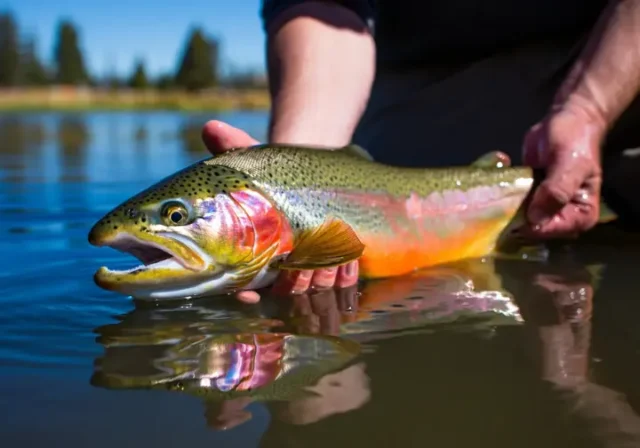In this article
Finding trout in the vast expanse of a lake can feel like searching for a specific current in the open water. Success in trout fishing hinges on understanding where these fish live, why they choose certain spots, and what tempts them to bite. We’ll explore the key factors influencing trout location, the best times to cast a line, and the most effective trout lures and baits to fill your net when catching trout in a lake.
This guide will serve as your map, navigating through lake habitats, optimal timing, proven artificial offerings like spoons and jigs, reliable natural baits, and essential fishing techniques from casting to trolling. We’ll even touch on using electronics and responsible trout angling practices. Ready to unlock the secrets to consistent lake trout success? Let’s dive in.
Understanding Trout Lake Habitat
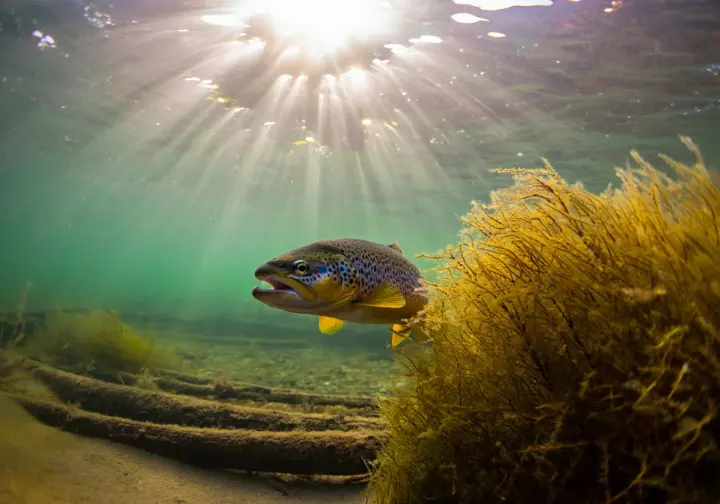
Knowing where trout prefer to hang out in a lake is like understanding the currents they swim in. It’s not random; their fish location is dictated by specific needs like water temperature, oxygen levels, food sources, and available cover within the aquatic life. Learning these preferences is the first cast towards successful trout fishing.
Key Factors Influencing Location
Members of the salmonidae family, trout are creatures of comfort, constantly seeking cool, oxygen-rich water. Many trout species thrive in temperatures between 48-55°F. This preference drives their seasonal movements. In summer’s heat, they often retreat to deeper, cooler zones near the thermocline. Conversely, during the more temperate spring and fall, when the entire lake cools, you’ll find them more spread out, often in shallower areas.
Some species, like Lake Trout (including siscowet lake trout in some regions), are true cold-water devotees, sticking to the depths year-round. You can learn more about general trout habits from the Oregon Department of Fish & Wildlife. Other common types like brook trout, brown trout, rainbow trout, cutthroat trout, and even rarer golden trout or tiger trout share this need for cool water, though specific preferences affect lake trout location differently.
Food is another major draw. Trout gather where meals are easy to come by. Think areas dense with aquatic insects, schools of trout minnows or smelt, or pockets holding crawfish. Productive zones often include weed beds, the mouths of inlets and outlets where food gets concentrated, or zones where baitfish school. Knowing the primary forage (bait fish) in a particular lake helps immensely in predicting where trout will be actively hunting.
Structure provides safety and strategic advantage. Trout use underwater features like submerged logs, rocks, aquatic vegetation, and drop-offs as hiding spots from predators and ambush points for unsuspecting prey. Points extending into the lake and the areas near inlets or outlets are also prime real estate where trout hold. Targeting these structural elements is like casting directly into the fish’s living room, significantly boosting your odds.
Light conditions play a role, too. Many trout, especially larger, more cautious ones like large brown trout, prefer feeding during low-light periods – think early morning, late evening, or overcast days. Bright midday sun often sends them seeking the security of deeper water or dense cover. Focusing your efforts during these prime feeding windows can make a real difference. Have you noticed better success during these times?
Finally, consider the difference between stocked trout (hatchery fish) and wild fish. Recently stocked, catchable-size trout might linger in shallower areas initially and can be less wary. They sometimes respond well to artificial baits like PowerBait, perhaps recalling hatchery food. Wild or holdover trout, having survived a season or more, are usually more cautious. They tend to prefer natural food sources and stick closer to classic trout habitat patterns dictated by temperature and structure. Maintaining native trout populations often involves different management strategies than stocked waters.
Locating Prime Lake Zones
Certain areas in a lake consistently act like magnets for trout. Inlets and outlets, where streams flow in or out, are hotspots. They bring cooler, oxygenated water and a steady supply of food washed in from the current, including aquatic insects adrift. Trout often hold just inside the main lake body near these transition points, waiting for a meal to drift by.
Underwater points that jut out into the lake and sharp drop-offs where the depth changes quickly are natural fish highways and ambush locations. These features offer trout easy access between shallow feeding zones and the safety of deep water. Using sonar or even a good contour map can reveal these hidden structures, turning a seemingly featureless area into a high-probability target for finding good trout fishing.
Don’t overlook the edges of weed beds. Aquatic vegetation offers crucial cover and hosts a buffet of insects and small fish, making these areas prime trout territory. Focus your casts or trolling passes along the deep edges of these weed lines, or probe any pockets and openings within the vegetation itself. Running a trout lure parallel to a weed edge can be incredibly effective.
During the heat of summer, the thermocline becomes critically important. This is the distinct layer separating the warm surface water from the cold, oxygenated deep water. Trout often suspend right at or just below this thermal boundary. Finding the thermocline, usually with the help of sonar, is often the key to locating fish during the hottest months in deep lakes.
In the transitional seasons of spring and fall, when water temperatures are more uniform throughout the lake, trout frequently move onto shallower flats to feed actively. These areas warm up faster in the spring sunlight and hold abundant forage. Casting trout lures or trolling baits across these shallower zones can be very productive after ice-out and during the autumn cool-down. Many expert trout anglers agree that spring is usually the best time of year to catch trout.
Timing Your Trout Trip
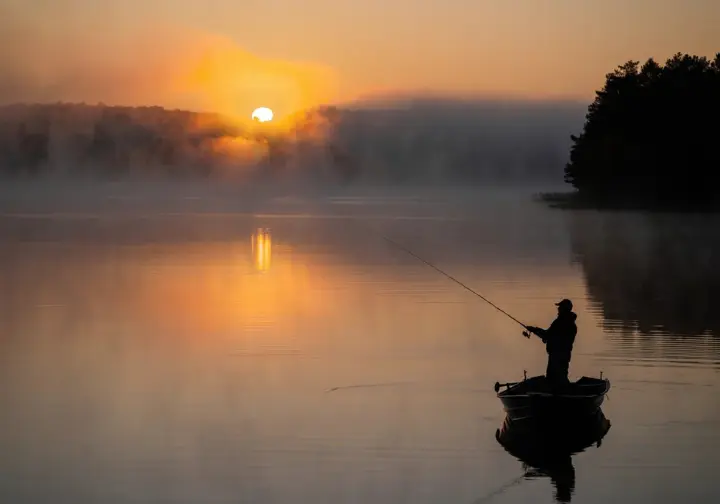
Just like knowing the right current, understanding when trout are most active is crucial for good trout fishing. Their feeding habits are influenced by daily light cycles and broader seasonal shifts tied to water temperature. Being on the water during these peak activity windows significantly increases your chances of encountering feeding fish.
Best Daily Feeding Times
The early morning hours, from first light until an hour or two after sunrise, often represent a golden window for lake trout fishing. The low light makes trout feel less exposed, encouraging them to move into shallower areas to feed actively. We’ve often found this period brings consistent action for active trout, sometimes accompanied by visible insect activity on the surface.
Similarly, the late afternoon and evening period, starting about three hours before sunset and lasting until dusk, offers another prime opportunity. As the sun dips lower, trout again feel more comfortable moving from deeper holding areas to hunt. This evening bite can be particularly strong during the warmer months when midday activity slows.
Don’t discount overcast days. The diffused sunlight under cloudy skies can extend the prime feeding window significantly. Trout may stay shallower and remain more active throughout the day compared to bright, sunny conditions. An overcast day following a period of high sun can sometimes trigger exceptional feeding activity. What’s your favorite weather for fishing?
For the truly dedicated fisherman, night fishing (where permitted) can yield surprising results, especially for large, wary holdover trout. Under the cover of darkness, these big fish often move into surprisingly shallow water near shorelines or structure to hunt. Quiet presentations are key for success after dark.
Conversely, the bright, sunny midday hours, particularly in summer, are often the toughest time to find active trout. They typically retreat to deeper, cooler water or bury themselves in heavy cover, becoming much less inclined to feed. If you find yourself fishing midday, focus your efforts on deep-water techniques like vertical jigging or trolling with downriggers to reach their comfort zone.
Seasonal Fishing Strategies
Spring, right after the ice melts, is often hailed as the premier season for lake trout and general spring fishing. The water is cool and oxygenated throughout, and active trout disperse widely, frequently cruising shallow areas near shorelines, points, and inlets. Casting trout lures or fishing bait under bobbers near the surface or shallow structure can be incredibly effective during this time. Those first ten days post-ice-out can be magical for catching trout in a lake.
As summer arrives and surface waters warm, trout seek refuge in the depths. Deep-water tactics become essential. Trolling with downriggers, lead core line, or vertical jigging over fish marked on sonar are the go-to methods. Concentrate your efforts during the low-light periods of early morning and late evening when fish might move slightly shallower or feed more aggressively near the thermocline.
The fall transition mirrors spring in many ways. Cooling water temperatures trigger trout to move shallower again and feed heavily, preparing for the coming winter. Casting and trolling near shorelines, points, and structure become productive once more. It’s a beautiful time to be on the water, but be mindful of spawning seasons and associated regulations for trout species like Brown Trout and Brook Trout.
Winter doesn’t mean the fishing stops; it just moves onto the ice (where applicable). Ice fishing for trout is popular in many regions. Trout remain active beneath the frozen surface and can be targeted effectively. Common techniques include using tip-ups baited with live minnows or actively jigging with small spoons or jigs. Focus on moderate depths, often near points, drop-offs, or submerged structure accessible through the ice.
Keep lake turnover in mind. This occurs in spring and fall when water temperatures become uniform from top to bottom, mixing oxygen and nutrients. During these brief periods, trout can be scattered at various depths. Trolling or systematically searching different depth zones becomes important until you locate concentrations of fish. Paying attention to water temperature readings can offer valuable clues for successful trout fishing.
Top Lures for Lake Trout
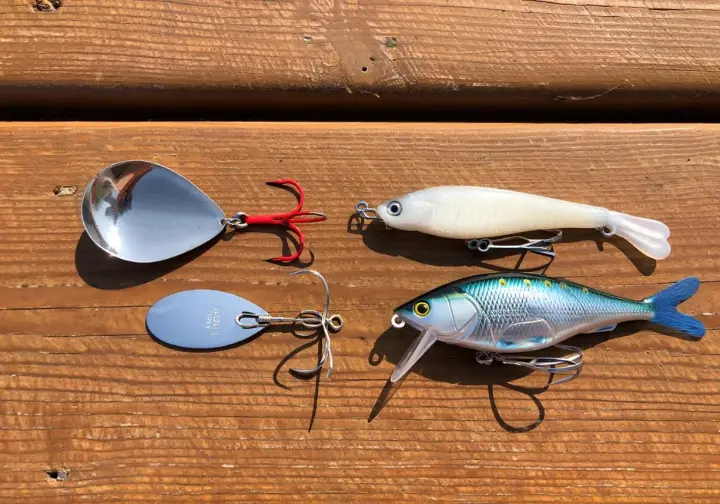
Choosing the right trout lure is like selecting the perfect current to drift your offering through – it needs the right action, depth, and appearance to entice a strike. Lake trout can be tempted by a variety of artificials, from classic flashing spoons and spinners to versatile jigs and realistic crankbaits. Understanding how and when to use each type is key among various fishing techniques.
Spoons and Spinners
Spoons are timeless trout catchers. Their wobbling action and flash mimic bait fish, specifically a wounded bait fish, making them effective whether you’re casting, trolling, or jigging vertically. You can control their depth and action by varying your retrieve or trolling speed. A crucial tip: always use a quality ball bearing swivel to prevent fishing line twist, especially when trolling these lures.
In-line spinners, like the venerable Rooster Tail or Panther Martin, attract trout through the vibration and flash of their rotating blade. They excel when cast out and retrieved steadily. The speed of your retrieve directly influences how deep the spinner runs – faster keeps it shallower, slower lets it sink. Like spoons, spinners are notorious fishing line twisters, so a good swivel is highly recommended.
When selecting color and size, classic spoon finishes like silver, gold, copper, or combinations with white are always solid choices. Brighter fluorescent colors can be effective in deeper or stained water. For spinners, metallic blades are standard, while body colors can range from natural hues to bright attractors. Try to match the lure size to the prevalent forage fish in the lake and the size of trout you’re targeting.
Presenting spoons effectively involves a few tricks. When casting, let the spoon flutter down to your desired depth before beginning the retrieve. Incorporating pauses or sharp jerks during the retrieve can often trigger strikes from following fish. For reaching deep summer trout while trolling, you’ll likely need downriggers, lead core line, or heavy inline weights. Heavier spoons can also be vertically jigged with good results.
With spinners, the main goal is a steady retrieve speed that keeps the blade turning consistently. Experimenting with retrieve speed is often necessary – sometimes trout want it slow and deep, other times faster and higher in the water column. Let the active fish tell you what they prefer on any given day. Popular spoon choices include the Little Cleo, Kastmaster, and Dardevle, while effective spinners include Rooster Tails, Panther Martins, and Mepps Aglias.
Jigs and Soft Plastics
The versatility of jigs makes them indispensable trout lures. Whether it’s a marabou jig, bucktail, tube jig, or a jig head tipped with a soft plastic trailer, these lures imitate a wide range of forage. They truly shine in vertical presentations for targeting deep fish marked on sonar. Their subtle actions can often tempt trout that ignore faster-moving lures. Blade baits also fall into this category and can be deadly when jigged.
Soft plastics bring incredible realism to the table. Swimbaits, grubs, and worm-imitations offer lifelike profiles and actions that can be irresistible, sometimes considered the top choice for targeting trophy lake trout. They can be fished vertically on a jig head, cast and retrieved slowly along the bottom, or even drifted weightlessly in shallower water.
Vertical jigging is a primary technique for deep-water trout, especially lakers in the summer or through the ice. After locating fish on your sonar, drop the jig down to their level. Use sharp lifts, gentle sweeps, hops, or simply hold and shake the jig. Strikes often come as the lure falls, so pay close attention. Sensitive fishing gear, like a rod with a fast tip and braided line, helps detect these subtle bites.
Choosing the right color and size for jigs and plastics depends on the situation. Natural baitfish colors like white, silver, and pearl are excellent imitators. However, bright or glow colors such as chartreuse, pink, or orange often trigger reaction strikes when jigging vertically in deep, dark water. For trophy lake trout, don’t shy away from large profiles (6-10 inches), while smaller plastics (1-3 inches) are standard for general trout fishing.
Some popular and effective jig and plastic options include white tube jigs, Spro bucktail jigs, Binsky blade baits, Trout Magnets, Berkley Gulp! Minnows, and Keitech swimbaits. For those chasing giants, large plastics like Bull Dawgs or Z Too shads are worth trying. Don’t forget floating worms like the Berkley Trout Worm, often fished on lighter jig heads or wacky-rigged.
Crankbaits and Plugs
Hard-bodied crankbaits and plugs are masters of baitfish imitation. They come in countless shapes and sizes, each designed with a specific wobble or darting action and a diving lip to reach a predetermined depth zone. These are excellent tools for trolling to cover vast amounts of water or for casting when targeting larger, predatory trout that feed heavily on smaller fish.
Trolling crankbaits is perhaps their most common application for lake trout. It allows you to efficiently search large areas and present your lure precisely at suspended fish depths, such as along the thermocline. Depth control comes from the lure’s diving lip design, the amount of fishing line let out, your trolling speed (typically 1-2 mph), and potentially the use of weighting systems like lead core line or downriggers. Deep-diving models are essential for summer success.
When casting crankbaits, a steady retrieve often allows the lure’s built-in action to work its magic. However, for suspending models, like the Rapala Husky Jerk, incorporating a jerk-pause retrieve can be deadly. This mimics a wounded or struggling baitfish, keeping the lure in the strike zone longer and often triggering aggressive bites from following trout. Have you tried this technique?
Color and size selection follows familiar principles. Natural baitfish patterns (silver, gold, perch, rainbow trout colors) are always reliable starting points. Brighter colors like fire tiger, chartreuse, or hot pink can excel as reaction strike triggers, especially in stained water or when trolling. Match the size profile to the lake’s forage base. For reaching significant depths, look for models specifically designed for deep diving, like the Rapala Tail Dancer or Down Deep Husky Jerk.
Many anglers have found success with popular crankbaits like the Rapala Original Floater, CountDown, Shad Rap, and Husky Jerk series. Other proven options include Worden’s FlatFish, Rebel TracDown Minnows, Berkley Flicker Shads, and Bomber Long As. Building confidence in a few specific models and colors is a good strategy for any fisherman.
Best Baits for Lake Trout
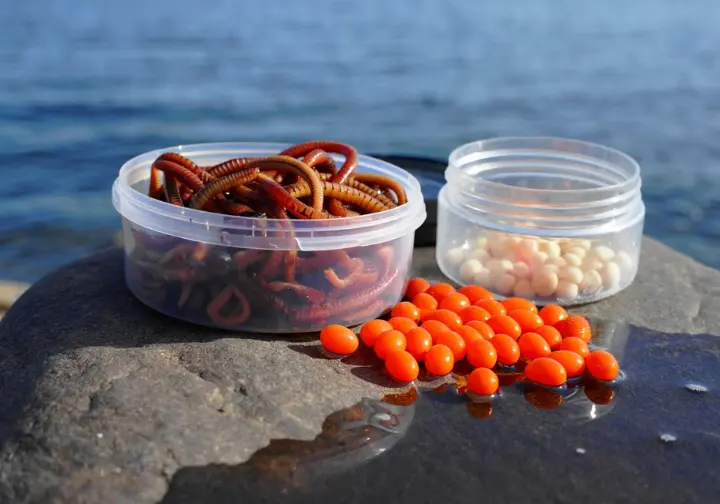
While lures offer action and imitation, sometimes the natural scent and taste of bait are what trout crave. From classic worms and minnows to modern scented artificials, bait fishing remains a highly effective way to catch lake trout. Pairing the right bait with the correct presentation rig (bait rigs) is the key to success.
Natural Bait Choices
The humble worm (nightcrawler) is arguably the most universal trout bait. Readily available and effective year-round, though perhaps shining brightest in spring, worms catch trout everywhere. Fish them whole or in pieces, either suspended under a bobber, drifted naturally near the bottom with minimal weight, or presented on a bottom rig. Their scent and wriggling action are hard for most trout to resist. These are classic natural baits.
Minnows, whether live (live bait) or preserved (salted, frozen), are excellent choices as they directly imitate a primary food source. Fish live minnows under a bobber, drifted, or trolled very slowly. Larger baitfish, like suckers or smelt (6-10 inches), are often the preferred offering when specifically targeting trophy-sized lake trout that key in on bigger meals. Always double-check local regulations regarding the use of live baitfish.
Small, scented, and visually striking fish eggs (like single salmon eggs) or egg clusters are particularly effective for rainbow trout and brown trout. Present them on small single hooks (sizes 10-16) fished near the bottom, often on a drift rig or suspended just off the bottom under a slip bobber. They can also be added to jigs as a “tipper” for extra scent and appeal. Using salmon egg presentations is a time-tested tactic.
Don’t overlook live insects when they are seasonally abundant. Grasshoppers, crickets, stoneflies, or grubs can be incredibly effective baits, perfectly matching what trout are naturally feeding on as part of their diet. Fish them on light wire hooks with minimal weight, allowing them to drift naturally on the surface or suspended just below under a tiny float. This often requires a delicate presentation but can be very rewarding.
While baits like corn kernels or small marshmallows can sometimes catch recently stocked trout (possibly due to resemblance to hatchery pellets), they are generally less effective for wary, wild trout compared to more natural offerings. Furthermore, the use of corn is restricted in some trout waters, so always verify local rules before using it. Focusing on worms, minnows, or eggs typically yields broader success across various fisheries.
Artificial Scented Baits
Commercial dough baits, with Berkley PowerBait being the most famous example, are exceptionally popular and effective, particularly for trout raised in hatcheries. These artificial scented baits combine potent scent attractants with bright colors, often mimicking the pellets fish were fed. Their inherent buoyancy is key – when used on a sliding sinker rig, the bait floats up off the bottom, right into the trout’s line of sight. Mold the dough completely around a small treble hook (sizes 16-18 are common). This floating style bait is a staple.
Power Eggs and Nuggets offer a convenient, pre-formed alternative to dough baits. They provide consistent buoyancy and are easy to rig. Simply thread one or two eggs onto a small single or octopus hook (sizes 6-10 work well), ensuring there’s enough lift to float the hook off the bottom when using a standard bottom rig (like a Carolina rig). These are also highly effective for stocked fish populations.
Hybrid baits like Berkley Powerbait Floating Mice Tails combine the profile of a small worm with an egg, offering a different look and subtle action in the water. Fish them just like you would dough bait or Power Eggs – typically on a bottom rig, allowing the tail to float upwards, or occasionally suspended under a slip bobber rig. Their unique shape can sometimes entice bites when standard egg or dough shapes are ignored.
One common mistake anglers make is sticking to just one color. Trout preferences for artificial bait color can change daily based on water clarity, light conditions, and frankly, fish mood. It’s vital to carry a variety of colors – chartreuse, yellow, pink, orange, white, rainbow, and various glitter combinations are all popular. Don’t be afraid to experiment until you find the hot color for the day. Start bright in murky water, more subdued in clear conditions.
It’s generally true that artificial scented baits excel in fisheries heavily reliant on stocking programs. Trout accustomed to artificial feed often respond readily to these offerings. While a wild trout might occasionally grab a PowerBait nugget, natural baits like worms, minnows, or insects are frequently more consistent producers for wary fish keyed into natural forage. Knowing the nature of the fishery helps guide bait selection for consistent fish.
Essential Bait Rigs
The bottom rig, often called a Carolina rig or sliding sinker rig, is the standard setup for fishing buoyant baits like PowerBait, Power Eggs, or marshmallows off the lake floor. A sliding egg sinker rests on the bottom, stopped by a swivel. Below the swivel, a leader (typically 1.5 to 5 feet long) allows the floating bait to lift up into the trout’s feeding zone. This is a highly effective presentation, especially from shore. These focused bait rigs are crucial.
For suspending bait at a specific depth, the slip bobber rig is incredibly versatile. An adjustable bobber stop on your main fishing line allows you to set the depth precisely, letting the bobber slide up the line until it hits the stop. This is perfect for targeting suspended fish marked on sonar at a certain depth, keeping bait just above weed tops, or presenting bait off the bottom in deeper water. Add split shot below the bobber to help the bait sink.
A fixed bobber rig is simpler but less adjustable. The bobber is clipped directly onto the line at a predetermined distance above the hook and split shot. This works well for fishing relatively shallow depths (e.g., 1.5 to 4 feet) or when targeting trout feeding very near the surface. It’s easy to set up but lacks the depth precision of a slip bobber.
When a natural presentation near the bottom is desired, especially for wary trout, a drift rig using minimal weight is effective. This typically involves just one or two small split shots placed 12-24 inches above the hook baited with a worm or minnow. The light weight allows the bait to drift naturally with subtle currents or wind action, appearing less artificial to cautious fish.
Targeting true trophy lake trout often involves presenting large baitfish (6-10 inches). Specific rigging is required. For still fishing, a single large circle hook through the baitfish’s nostril allows it to swim somewhat naturally. For vertical jigging or controlled drifting, a “quick strike” rig often involves a treble hook placed near the bait’s head or dorsal fin, sometimes with added weight above the leader. These bait rigs are designed for handling large baits and powerful fish.
Mastering Lake Fishing Techniques
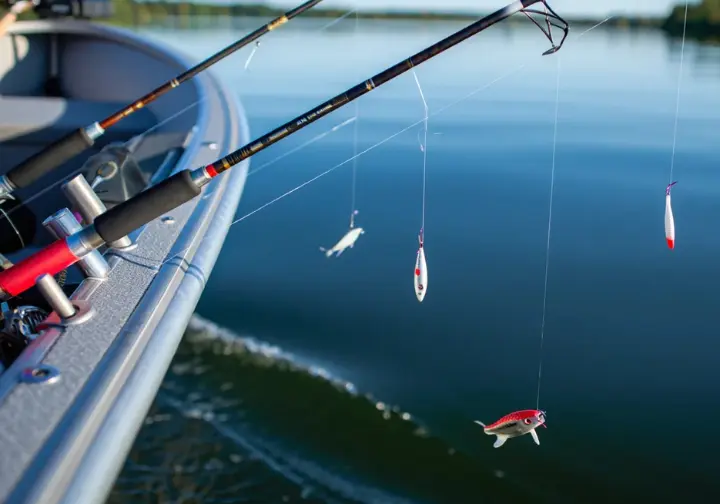
Knowing where and when to find trout, and what lures or baits to use, is only part of the equation. Applying the right fishing technique bridges the gap between potential and success – locating trout, applying the right tactic, and presenting your bait effectively are all essential. Key methods for lake trout include casting from shore or boat, trolling to cover water efficiently, vertical jigging for deep dwellers, and specialized fly fishing approaches for stillwaters.
Casting Lures and Bait
Lure casting is fundamental. It involves throwing lures like spinners, spoons, crankbaits, or jigs towards likely trout-holding spots – think structure, weed lines, points, or drop-offs – and then retrieving them to imitate prey. Varying your retrieve speed and letting lures sink to different depths before starting the retrieve are key adjustments. Good casting mechanics maximize distance and accuracy, crucial when fishing from shore to reach productive zones. Baitcasting gear can be useful here.
When casting bait, the goal is to position your chosen rig (bottom rig, slip bobber, fixed bobber) strategically in an area where trout are likely to be. This could be near a drop-off, along a weed edge, or close to an inlet. Unlike lure fishing, bait fishing often involves more waiting. Patience is required as you let the scent and natural appearance of the bait do the work.
Shore fishing presents unique challenges. Anglers need to maximize casting distance to reach deeper water or offshore structure, particularly during summer when trout move deep. Look for points that extend far out, drop-offs accessible from the bank, or areas near stream inlets. Sometimes wearing waders allows you to get a few extra feet out to reach better water. A helpful resource for beginners is A Guide to Fishing for the First Time | U.S. Fish & Wildlife Service.
A boat offers significant advantages for casting. Mobility allows access to offshore humps, distant weed beds, and structure unreachable from the bank. Using sonar, you can pinpoint targets and position the boat perfectly for casting towards them. An anchor or a spot-lock feature on a trolling motor helps maintain boat position while you thoroughly work an area.
Don’t fall into the trap of a monotonous retrieve. Varying your retrieve is often what triggers strikes. Experiment with retrieve speed – fast, slow, medium. Add pauses, especially with jigs or suspending crankbaits. Incorporate twitches or sweeps of the rod tip to give spoons or jigs an erratic, wounded action. These changes in movement often convince following fish to commit.
Trolling Techniques for Coverage
Trolling is a highly effective method for searching large expanses of lake water and locating scattered or suspended trout. It involves dragging lures or baits behind a slowly moving boat, typically at speeds between 1 and 2 miles per hour. Consistent speed and, crucially, depth control are the cornerstones of successful trolling. What is trolling in fishing? provides a good overview of this fishing technique.
Achieving the right trolling depth, especially when targeting trout holding deep in the summer thermocline, requires specific fishing gear. Deep-diving crankbaits have built-in lips to help them plunge. Lead core line, which sinks due to its weighted core, is another option. Downriggers offer the most precise depth control, using heavy weights to take lures down. Adding inline weights or using diving planers like Dipsy Divers are other ways to get deeper.
A wide range of lures can be effectively trolled for lake trout. Spoons, diving crankbaits (like Rapalas or Flatfish), spinners (especially Wedding Ring styles often tipped with bait), plugs, swimbaits, and even large streamer trout flies are common choices. Match the lure type, size, and color to the conditions, depth, and likely forage. Always use swivels to minimize fishing line twist.
While 1-2 mph is a standard trolling speed range, don’t be afraid to experiment. Sometimes speeding up slightly or slowing down triggers more bites. Subtle S-turns with the boat can also impart action to the lures, speeding them up on the outside turn and slowing them down on the inside. Using GPS or a fish finder to monitor your speed accurately is helpful.
Instead of trolling randomly across open water, try following specific depth contours, the edges of drop-offs, or distinct weed lines where fish are likely to concentrate. Using sonar and lake maps helps you stay on these productive underwater highways, sometimes known as fish breaklines. Making occasional zig-zag patterns across a contour line can help cover slightly different depths and potentially intercept more fish.
Vertical Jigging Deep Trout
Vertical jigging is a precision technique, ideal when trout are concentrated in deep water, often relating to specific structure or baitfish schools found on sonar. You position the boat directly over the fish or structure marked on sonar and drop a lure vertically to their depth. This is particularly effective for deep-dwelling lake trout, especially during summer or when ice fishing. Good boat control and accurate sonar interpretation are key.
The jigging motion itself involves imparting action to the lure primarily with the rod tip. After letting the jig reach the bottom or the target depth, use lifts, drops, sharp hops, shakes, or long, slow sweeps. Many strikes occur as the lure flutters back down after a lift, so always be ready. Experiment with different cadences – sometimes aggressive, sometimes subtle – until you find what the fish respond to.
Sonar is your underwater eyes for vertical jigging. Use it to find fish (often appearing as arches or marks near the bottom), schools of baitfish, or distinct structure like humps or rock piles in deep water. Position the boat so your transducer (and thus your lure) is directly over these targets. Being slightly off can mean missing the fish entirely.
For effective deep-water jigging, specialized gear helps. A medium-action spinning rod with a sensitive tip is crucial for detecting subtle bites far below. A quality reel with a smooth drag is needed to handle potentially large fish. Many anglers prefer braided line for its minimal stretch, which enhances sensitivity and hook-setting power in deep water, often paired with a fluorocarbon leader for stealth and abrasion resistance.
Effective jigging lures need to get down deep quickly. Heavy metal spoons, blade baits (like the Binsky), tube jigs filled with lead heads, bucktail jigs, and jig heads tipped with soft plastic swimbaits or fluke-style baits are all excellent choices. In the dark depths, bright colors (chartreuse, pink, orange) or glow colors often outperform natural colors by triggering reaction strikes. Match lure size to the target trout species and available forage.
Fly Fishing Stillwaters
Fly fishing isn’t just for rivers; it can be highly effective on lakes too, though the techniques differ. One popular method is chironomid fishing. This targets trout feeding on midge pupae emerging from the lake bottom, a staple food source in many lakes. It involves suspending small chironomid fly patterns under a strike indicator at a precise depth, often just inches off the bottom. The presentation is usually static or involves an incredibly slow retrieve. This is classic textbook fly fishing for stillwaters.
For targeting larger, more predatory trout, streamer fishing tactics are the way to go. This involves casting larger trout flies (streamers) that imitate baitfish, leeches, or even crayfish towards structure like shorelines, drop-offs, or weed beds. The retrieve typically consists of strips and pauses to simulate the movement of prey. Getting the streamer down to the fish’s level usually requires using sinking fly lines (intermediate, sink-tip, or full sinking) paired with a suitable fly reel.
Choosing the right fly line is critical for stillwater success. Floating lines are standard for fishing with strike indicators (like chironomid fishing) or presenting dry flies during surface hatches. For streamer fishing, various densities of sinking lines are needed to reach different depths effectively. An intermediate line sinks slowly for shallower presentations, while sink-tip or full sinking lines (often designated by sink rate, e.g., Type 3 or Type 6) get flies down much deeper.
A well-rounded selection of stillwater fly patterns is important. Essential chironomid patterns mimic the larval (bloodworm red, green) and pupal stages (black, olive, brown, often with metallic ribbing or bead heads) in sizes typically ranging from 10 to 18. For streamers, versatile patterns like Woolly Buggers, Clouser Minnows, leech imitations, and sculpin patterns are effective. Articulated streamers can offer even more enticing movement for larger fish.
Whether fishing nymphs under an indicator or stripping streamers, depth control is paramount in lake fly fishing. When indicator fishing, meticulously adjust the depth setting based on sonar readings or by systematically probing until you find the bottom. For streamers, selecting the correct sinking line density and varying your retrieve speed and pauses are how you control the depth and action of the fly.
Finding Trout with Electronics
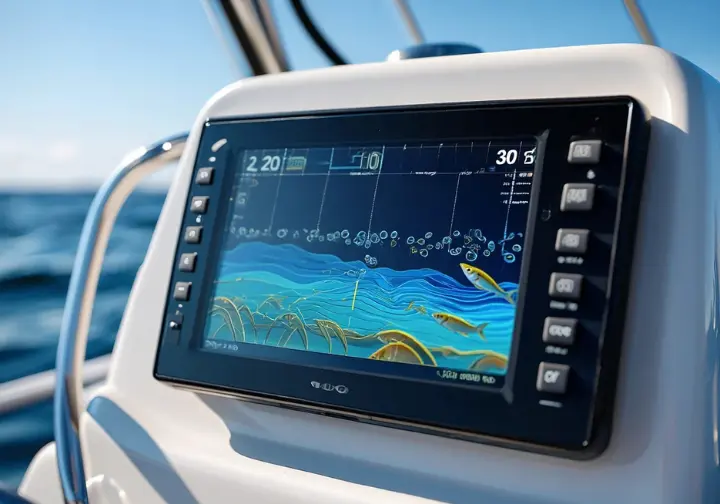
While traditional water reading skills are invaluable, modern fish finders (sonar) offer a powerful advantage in locating trout, especially in large or deep lakes. Electronics help identify key underwater structures, pinpoint schools of baitfish, and even mark the trout themselves, significantly reducing search time and increasing fishing efficiency.
Reading Lake Features Visually
Even without electronics, sharp observation reveals much. Focus on visible structure along the shoreline: points extending into the lake, visible rock piles, submerged logs near the bank, distinct edges where weeds end, and areas where streams enter or exit. These are natural congregation spots for trout, offering cover or food in trout-habitat-looking water.
Pay attention to wind direction. Wind pushes surface water, concentrating plankton and insects along the downwind shoreline. This often attracts baitfish and, consequently, feeding trout. Conversely, the calmer water on the lee (protected) side of the lake might offer refuge during strong winds. Considering the wind is a simple but effective tactic.
Keep an eye out for surface activity. Rings on the water signal rising fish taking insects off the surface – a direct giveaway of their location and feeding behavior. Diving birds can also indicate surface insect hatches or schools of baitfish being pushed upwards by predators below. These visual cues are valuable clues. Trout feed upwards often, making surface activity a key indicator.
Observe the water clarity and color. In very clear water, trout might hold deeper or be more easily spooked, suggesting longer casts, lighter fishing lines, and perhaps more natural lure colors. Stained or slightly murky water might make trout feel more secure in shallower areas and potentially more aggressive towards brighter or vibrating lures.
Look for transition zones – areas where one type of bottom meets another (like rock transitioning to sand) or where shallow flats abruptly drop off into deeper water. These edges often act as travel corridors and feeding areas for trout. Even subtle changes in depth or bottom composition can be significant holding spots where fish tend to congregate.
Interpreting Sonar Signals
Understanding traditional 2D sonar is fundamental. It shows the depth directly below the boat, indicates bottom hardness (a thin, bright line usually means hard bottom; a thicker, fuzzier band suggests soft bottom), and marks objects suspended in the water column. Fish often appear as arches as the boat moves over them, or as distinct lines or hook shapes if stationary. Structure like rocks or submerged trees shows as defined shapes rising from the bottom contour.
Identifying baitfish schools is often a primary goal when using sonar. They typically appear as dense clouds, tightly packed balls, or large clusters of small individual marks on the 2D screen. Finding these bait schools is crucial because predator fish, like trout, are rarely far away. Look for larger arches (game fish) near or below these bait balls.
Spotting larger game fish on 2D sonar usually involves looking for those distinct arches or thicker lines/hook shapes. Their position relative to structure, baitfish, or specific depth zones (like the thermocline) provides valuable information. Seeing marks consistently at a certain depth suggests where you should focus your presentation. Learning to distinguish fish marks from other clutter takes practice.
Side Imaging sonar provides a different perspective, scanning horizontally out to the sides of the boat. It excels at showing structure like rock piles, weed beds, or sunken logs located away from your direct path. Objects appear as bright returns, often casting shadows behind them; the length of the shadow indicates the object’s height off the bottom. It’s a powerful tool for quickly searching large flats or locating specific pieces of cover.
Properly adjusting sonar settings is vital for clear interpretation. Sensitivity is key: too high, and the screen fills with clutter; too low, and you might miss fish or subtle details. Adjust sensitivity until you get a clean picture showing fish arches and bottom detail clearly. Using the zoom feature to focus on a specific depth range (like the bottom 20 feet) provides much greater detail in that zone. A common recommendation is to turn off the “Fish ID” symbols (the little fish icons) and learn to interpret the raw sonar signals (arches and lines) yourself for better accuracy.
When specifically targeting lake trout with sonar, focus your search in deep water, especially during summer (often 60-150+ feet). Look for marks close to the bottom, particularly relating to steep drop-offs, underwater humps, or points. Often, lake trout will position themselves below schools of suspended baitfish like ciscoes or smelt. Identifying these deep-water structures and bait concentrations is key to finding lakers and other common lake trout.
Responsible Lake Trout Angling
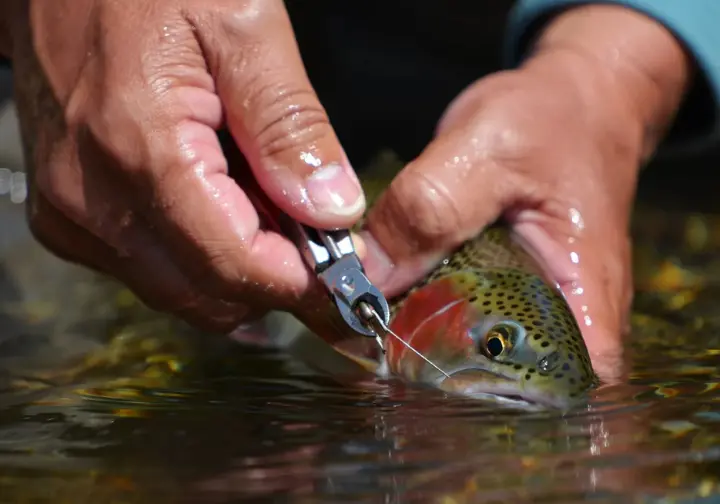
Catching trout is only part of the experience; being a responsible steward of the resource is equally important. This means understanding and following fishing regulations, practicing proper catch-and-release fishing techniques when appropriate, and adhering to general angling ethics and safety measures to ensure healthy fisheries for the future. Organizations like Trout Unlimited champion these efforts.
Protecting the Resource
Always start by knowing the regulations for the specific lake or water body you plan to fish. This includes verifying fishing license requirements, checking open fishing seasons, understanding daily creel (harvest) limits, and knowing any minimum or maximum size restrictions. Regulations often vary between lakes and can change annually. They are essential tools for managing fish populations sustainably, guided by fish biologists and local fisheries managers. You can usually find these details on your state’s fish and wildlife agency website, like the New York State Department of Environmental Conservation page for stream trout (principles often apply to lakes). Be aware of potential bait restrictions in certain trout waters.
If you plan to release your catch, practice proper catch-and-release. Minimize the time the fish spends out of the water – seconds count. Wet your hands before handling the fish to protect its sensitive slime coat. Use barbless hooks whenever possible, as they allow for much quicker and less damaging hook removal. Land the fish quickly; don’t play it to exhaustion.
Proper hook removal is vital. Use needle-nose pliers or hemostats to grasp the hook shank and back it out gently. If a fish hook is swallowed deeply in the throat or gills, it’s often best to cut the fishing line as close to the hook eye as possible rather than attempting to rip it out, which can cause fatal injury. Again, barbless hooks make this process significantly easier and safer for the fish. Choosing the right hook size for trout fishing can also influence hook placement and ease of removal.
Adhere to good angling ethics and etiquette. Give fellow anglers plenty of space – don’t cast over their lines or crowd their spot. Avoid making excessive noise, especially near others or in quiet settings. Crucially, practice “Leave No Trace” principles: pack out everything you pack in, including tangled fishing line, bait containers, and food wrappers. Be mindful of sensitive habitats like spawning habitat.
Safety should always be the top priority. Fish with a companion if possible. Handle hooks and sharp tools carefully. Be aware of your surroundings when casting, especially near other people or obstacles. When boating, or wading in potentially swift or deep water, always wear a personal flotation device (PFD). Check the weather forecast before you leave and be prepared for changing conditions. Avoid potential fish borne diseases by handling fish properly.
If you decide to harvest fish within the legal limits, do so responsibly. Dispatch the fish quickly and humanely. Clean the fish promptly to prevent spoilage. Store the fish properly on ice in a cooler to maintain its quality and ensure the best possible table fare. Respecting the resource extends to caring for the trout caught.
Frequently Asked Questions
What is the single best lure for lake trout? >
What is the best bait for stocked trout in lakes? >
Do I need a boat to catch trout in a lake? >
How deep do trout go in lakes during summer? >
We are a participant in the Amazon Services LLC Associates Program, an affiliate advertising program designed to provide a means for sites to earn advertising fees by advertising and linking to Amazon.com. As an Amazon Associate I earn from qualifying purchases. We also participate in other affiliate programs. The information provided on this website is provided for entertainment purposes only. We make no representations or warranties of any kind, expressed or implied, about the completeness, accuracy, adequacy, legality, usefulness, reliability, suitability, or availability of the information, or about anything else. Any reliance you place on the information is therefore strictly at your own risk. Additional terms are found in the terms of service.


